I am doing an assignment involving percolation--long story short, I have an array of arrays that represents a grid, and every entry is -1, 0, or 1. I have the assignment essentially done, but one part asks for a graphical representation of the matrix using colors for each possible entry. But from the way the assignment is worded, it sounds to me like perhaps I shouldn't be using anything not found in standard Python 2.7 and numpy.
I couldn't think of how to do it so I just went ahead and import pylab and plotted every coordinate as a large colored square in a scatter plot. But I just have this nagging concern that there's a better way to do it--like there's a better package to use for this task, or like there's a way to do it with just numpy. Suggestions?
If it helps, my current code is below.
def show_perc(sites):
n = sites.shape[0]
# Blocked reps the blocked sites, etc., the 1st list holds x-coords, 2nd list holds y.
blocked = [[],[]]
full = [[],[]]
vacant = [[],[]]
# i,j are row,column, translate this to x,y coords. Rows tell up-down etc., so needs to
# be in 1st list, columns in 0th. Top row 0 needs y-coord value n, row n-1 needs coord 0.
# Column 0 needs x-coord 0, etc.
for i in range(n):
for j in range(n):
if sites[i][j] > 0.1:
vacant[0].append(j)
vacant[1].append(n-i)
elif sites[i][j] < -0.1:
full[0].append(j)
full[1].append(n-i)
else:
blocked[0].append(j)
blocked[1].append(n-i)
pl.scatter(blocked[0], blocked[1], c='black', s=30, marker='s')
pl.scatter(full[0], full[1], c='red', s=30, marker='s')
pl.scatter(vacant[0], vacant[1], c='white', s=30, marker='s')
pl.axis('equal')
pl.show()

